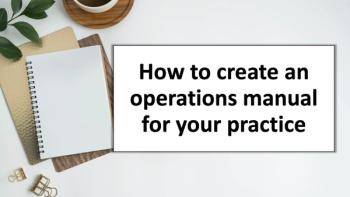
Patient Relations: Suspect Science – Sorting Fact From Fiction
Have you heard that aromatherapy cures cancer? Or that wheat grass prevents baldness? At least one of your patients probably has. Keep them focused on what’s proven to help.
Family physician Jane Murray knew she’d attract patients who had decidedly nonallopathic ideas about healing. Her successful cash-only solo practice, Satun Center of Integrative Health Care (named after an ancient Mayan healing concept), in Mission, Kan., employs licensed and certified practitioners in acupuncture, naturopathy, and clinical psychology, as well as a massage therapist and a Chinese medicine practitioner.
“[Patients] do bring some interesting ideas to me,” says Murray - whose new patients often must wait three months for an initial appointment. She says that if a patient asks about a remedy she’s unfamiliar with, “I tell them I haven’t seen any scientific research done about the particular area they are asking about, but I’ll look into it.”
Murray attends several conferences a year and keeps tabs on scientific journals in both the allopathic and alternative medicine realms. Still, some patients’ requests catch her by surprise. They may ask her about high-energy magnet therapy. Others may want a liver detoxification flush using various herbal concoctions. Or they may demand chelation therapy. Murray neither provides nor advocates such treatments. She also once refused to prescribe a powerful antifungal a patient insisted was the only treatment that would clear up her “systemic yeast infection.”
Murray’s story is typical of today’s physician. The National Health and Nutrition Examination Survey, conducted by the Centers for Disease Control and Prevention, says more than half of American adults use supplements on a regular basis - primarily vitamins and minerals, but also herbs and other nontraditional remedies. And millions of recent immigrants from Asia, Africa, the Caribbean, and Central and South America are bringing their own culture-based ideas about healing with them to their new home, putting the onus on Western-trained physicians to dig up and decode remedies unfamiliar to them.
Indeed, many physicians feel inundated by a tidal wave of patients inquiring about and often using treatments that can be classified at best, “alternative,” and at worst, “junk science.” Perhaps a patient heard a radio ad for “super green tea” (a highly concentrated tea leaf extract). Or he followed a friend’s tip to consume high doses of garlic (which can have an anticoagulant effect) to “clean out his system” just before undergoing major surgery.
James Glazer, a family physician in Portland, Maine, succinctly summarizes his method of detecting and classifying nontraditional remedies, saying: “There’s allopathic junk science and alternative junk science.” He recalls a patient who claimed her scalp was covered with tiny bumps that were undetectable to him. She demanded he prescribe her an antibiotic. Giving her an unwarranted prescription would have been just as questionable as any other unproven therapy, says Glazer. He adds that misleading coverage of biomedical research findings by the consumer press, combined with direct-to-consumer advertising of prescription pharmaceuticals, appears to be increasing patient requests for unsound medical solutions.
Internist Mack Lipkin, director and professor of the division of primary care at New York University, agrees: “We’re coming into a situation where there’s a growing disparity between the patient’s beliefs and [the physician’s], and the gap seems to be growing.”
Determining which powders, potions, pills, or other nontraditional therapies your patients may be sampling often requires a series of well-timed, open-ended questions, says Linda Barnes, PhD, a medical anthropologist and associate professor at Boston University School of Medicine: “Many people worry about pharmaceuticals and have the mistaken notion that if something can be classified as ‘natural’ then it won’t have side effects, so they don’t mention it.”
As a physician, you may already know the dangers of mixing St. John’s wort (Hypericum perforatum) with an MAO inhibitor. The bigger hurdle is getting your patient to tell you he’s taking the herb in the first place. And then there’s the challenge of convincing patients of the potential risks of ingesting homeopathic products, which may share pharmacy shelf space with, say, the comparatively harmless Flintstones multivitamins.
How do you find common ground between you and your patients? Barnes and other experts in medical communication recommend following a multistep process to form patient alliances by developing physician-patient trust, taking the time to learn each patient’s specific health beliefs, being open-minded when educating yourself about alternative regimens, and negotiating with your patient a mutually agreeable treatment plan.
In one another we trust
Gaining a patient’s trust takes time, but it’s critical to successful outcomes. It’s especially difficult to achieve such success when patients and physicians come from different social, educational, ethnic, and economic backgrounds, says Ira SenGupta, executive director of the Seattle-based Cross-Cultural Health Care Program.
“With comfort comes trust. With trust comes effective communication,” says SenGupta. “You can’t just jump in and say, ‘Tell me everything you are using,’ and expect full disclosure.”
SenGupta says her program helps physicians develop more workable communication skills, from learning how to enhance their body language to using interpreters productively. With some patients, building a sufficient level of trust may take more than one or two visits, especially when patients and physicians have particularly different backgrounds.
“The United States is a nation of immigrants, and each wave brings its traditions,” says Lipkin.
Murray thinks bridge-building exercises are necessary with all patients - not solely those from other cultures. “I practice cross-cultural medicine in almost every encounter because so many people now have a different idea about what’s important to them,” she says. “I have patients who come in and say, ‘I won’t take a prescription.’ They’ll take 27 herbs but won’t take a prescription drug.”
To build mutual trust with a patient, begin by discussing her use of the most basic and safest of supplements - the daily multivitamin. Lipkin often discovers that his Medicaid patients spend several dollars a day on basic vitamin supplements hyped as “super,” “more effective,” or “natural.” Lipkin tells those patients to find comparable store brands that are available at a fraction of the amount they are spending.
Taking time to build a patient’s trust in your abilities makes it more likely that patient will share her full health history, including any nontraditional supplements or remedies she may be taking. The benefit? An accurate diagnosis and subsequently appropriate treatment.
Patients think the darnedest things
Why do so many American adults use supplements and herbal remedies on a regular basis? Because they believe in them.
The roots of such beliefs can originate just about anywhere - from a casual suggestion by a slight acquaintance to centuries of inherited cultural wisdom carried to the New World. Regardless, Lipkin and other experts say physicians must assess each patient’s beliefs about healthcare with the same attention to detail they would devote to a physical exam. They readily admit that determining whether a patient regularly sips a heady cup of licorice tea, consumes a daily extract of echinacea, pops garlic pills, or swallows mega-doses of zinc might take a bit more investigative work.
“People say that digging into those concepts with the patient takes extra time, but, believe me, it takes much less time to get it right the first time than doing a lot of dose adjusting and irrelevant fixes visit after visit while the patient gets worse and possibly does damage to himself or herself,” says Lipkin.
The Natural Products Association, a trade group for the manufacturers of dietary supplements and other health and beauty aids, says about one in five older Americans reports taking herbal supplements. Unfortunately, few of the approximately 30,000 dietary supplements on the U.S. market have undergone rigorous scientific testing for safety and efficacy. Because of this, the average consumer may not appreciate a natural remedy’s potential dark side.
For example, a physician prescribing lorazepam for anxiety may not know that the patient is already taking the herb kavakava for the same reason. Taking the two together can reduce motor control.
Spending a few extra minutes with a patient could prevent a potentially dangerous drug interaction between a supplement and a prescribed medication. But even if you’re willing to take this time, unearthing a patient’s use of alternative medications, supplements, and other nontraditional therapies can be tricky. Many patients keep such information to themselves. They regard their trove of vitamins, herbs, powders, and extracts as food products - that is, items kept in the kitchen cupboard and certainly not worth mentioning to their doctor. Others fear their physician would be biased against non-Western, nontraditional therapies.
Barnes - who also is director of the Boston Health Landscape Project, a program that helps patients and physicians bridge cultural divides - notes it’s still common for doctors to be taken aback when a patient suggests a new treatment possibility. What patient wants to risk a scolding or endure condescension for admitting to engaging in alternative therapies that a physician may frown upon?
Lipkin suggests asking patients a series of nonthreatening questions meant to uncover what treatments they perceive as credible. For example, he says, ask your patient:
- What do you think might be wrong?
- Do you have a name for what is bothering you?
- What do you think is causing this?
- Do you have any ideas about what might make this better or worse, or things that should or should not be done?
Adopting this approach shows you are interested in your patient’s concerns, respectful of his beliefs, and willing to work toward a cooperative solution.
Barnes adds that some patients expect their physicians to deal only with the physiological aspects of illness, assuming they must find spiritual and emotional help elsewhere. You can help ease a patient’s mind by asking questions such as these:
- What in particular are you hoping I can help you with?
- Are you seeing anybody else or doing anything else about other aspects of this problem?
Just the very act of posing some well-phrased questions can sometimes unclog communication blocks. Lorenzo Cohen, PhD, director of the Integrative Medicine Program at the University of Texas M.D. Anderson Cancer Center in Houston, says the main reason patients withhold information about complementary or alternative therapies they may be taking is that their physicians never ask about them.
“A direct question about herbals or supplements or large vitamin doses has to be part of every patient history, whether verbal or written,” Cohen says. “We know that up to half of all patients are doing or taking something, so saying, ‘The patient never mentioned it,’ when something goes wrong just doesn’t cut it anymore.”
Know your herbs
So let’s say you discover your patient is convinced that the three cups of green tea she drinks each day will prevent her from developing cancer. What do you do?
That depends. Will it? Unless you’re well-schooled in the efficacy of homeopathic remedies, you may not be able to say definitively either way. Tread carefully here - you want to maintain that all-important trust relationship you’ve built up with this patient as well as your own credibility.
“I try not to be disparaging about things I don’t know about,” says Glazer. “I remind them that they are coming to me for advice on my area of expertise. I also try to remind them that not all treatments are benign and just because we don’t know about it doesn’t mean it’s going to be safe.”
Murray concurs. “People go on the Internet and see a checklist of symptoms and get convinced that’s their problem too, so they demand a specific treatment or start taking some herb that may not be at all right for them,” she says. She adds that when patients ask about something she isn’t aware of, one phrase usually works: “I’ll look into it and get back to you.”
So after buying some time, follow up and check it out. Or at least try to. Physicians can find numerous resources on the Internet that describe alternative therapies, including many known herb-drug interactions.
Barnes suggests homing in on an unfamiliar herb by first searching the Web for whatever name the patient gives you. Determine its Latin name, if possible. Then search credible sources, such as the Cochrane Review or the National Center for Complementary and Alternative Medicine, for descriptions of that herb. Of course, you probably won’t know whether that bottle of North American black cohosh (Cimicifuga racemosa) your patient bought to ease her menopause symptoms actually contains a cheaper (and chemically different) imitator from Asia, as the Journal of Agricultural and Food Chemistry found in three out of 11 black cohosh products researchers recently analyzed. But at least you’ll know something about what it does.
With so many new - and frequently unfounded - claims about herbal and dietary supplements or other nontraditional therapies, digging up unbiased scientific information can be time-intensive. Just try Googling “magnets” and “pain.” You’ll get 30 million-plus hits.
Notably, the highest-ranking page for many Web queries on alternative medicine topics is the National Institutes of Health National Center for Complementary and Alternative Medicine. But the site’s rational explanations of the current state of alternative medicine are still often overlooked. And especially on the Web, a slick appearance doesn’t always mean the information presented is credible.
Although many pitches for unproven remedies tout highly dubious claims on homemade-looking Web sites, other marketers of questionable therapies may spin big budgets into sophisticated presentations, putting forth a convincing appearance. Consider
Knowing the difference between legit and two-bit can empower you to guide your patients through the information highway more effectively.
Negotiate for cooperation
Lipkin, a cofounder of the American Academy of Communications and Health, which promotes research into patient-physician communication, notes: “It’s probably the norm - not the exception - that people have their own ideas about what’s making them sick, what will make them better, and how you should go about investigating those things.”
Clearly, the physician-patient alliance is based on safety, efficacy, and value, says Lipkin. “You want to try and understand the problem as much as you can in the patient’s terms, but you make it clear that your part of the alliance is using your special knowledge to help them avoid things that are unsafe or that are a rip-off.”
Some formerly disparaged ideas do enter mainstream medicine. Chiropractic, now widely accepted as a complementary therapy for certain ailments, emerged from the state of Iowa a century ago, when Canadian-born, Daniel Palmer, MD, improved the hearing of a deaf janitor by adjusting a vertebra in his back.
But in some ways, our nation has reverted to the “bad ol’ days” before the U.S. Food and Drug Administration was established in 1906. Medicinal quackery then and now sings similar tunes. Today’s media ads touting herbal and dietary supplements for weight loss or increased male libido eerily parallel 19th-century traveling charlatans peddling cure-nothing tonics.
Many still succumb, with some growing so noncompliant they become nearly impossible to treat. No physician likes to dismiss a patient, even for noncompliance, but what if Mrs. Winkleberry with high blood pressure refuses to take a doctor-prescribed medication in favor of an herbal remedy, zinc supplements, and tai chi classes?
Murray says she carefully explains to noncompliant patients the risks they run when refusing a prescribed medication in favor of an alternative approach untested by the FDA. She documents the conversation in the patient’s chart, saying, “Look, this is your life, your health, and your future. I don’t want to see you in the ICU. If you want to try working with lifestyle, magnesium, calcium, garlic, relaxation, breathing, and so on, go ahead, but why not take this general medicine while you work on those things?”
This statement shows respect for your patient, even if Mrs. Winkleberry refuses to budge.
You may eventually find that all-important common ground, perhaps combining your views into a reasonable, effective treatment plan you both can live with. Which is, after all, the point.
Bob Redling has written on practice management topics for more than nine years. He has been practice management editor for Physicians Practice, Web content editor and senior writer for the Medical Group Management Association, and a speechwriter for the American Academy of Family Physicians. He can be reached via
This article originally appeared in the October 2006 issue of Physicians Practice.
Newsletter
Optimize your practice with the Physicians Practice newsletter, offering management pearls, leadership tips, and business strategies tailored for practice administrators and physicians of any specialty.











